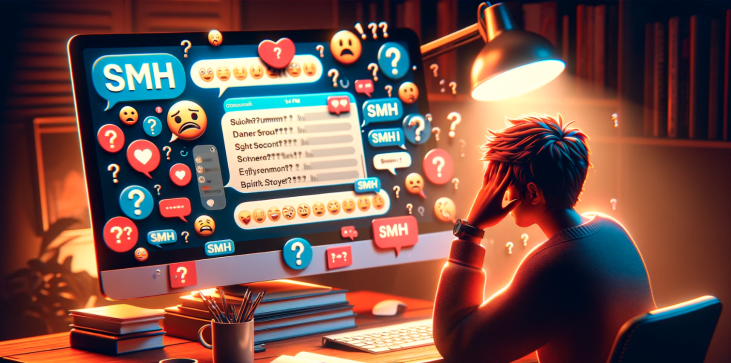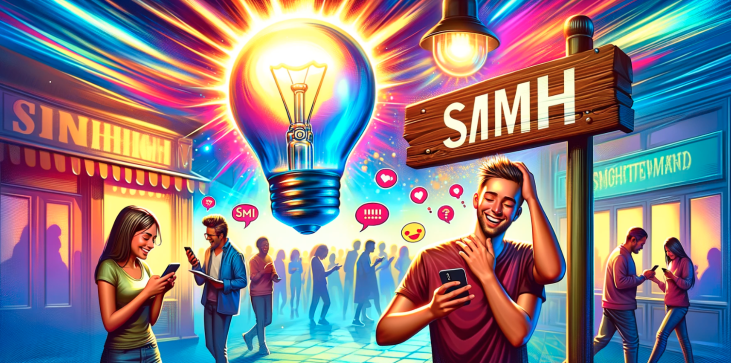
Internet slang and acronyms are a pivotal part of digital communication, reflecting the evolving landscape of how we express ourselves online. As someone who has both witnessed and participated in the digital world's linguistic revolution, I've become particularly intrigued by one abbreviation that seems omnipresent yet often misunderstood: 'SMH.' Today, I'm diving deep into this three-letter enigma to unravel its mysteries and share my findings with you.
I recall the first time I encountered 'SMH' in a text message. I was perplexed, staring at the screen, trying to decipher what my friend was attempting to convey. The acronym 'SMH' is a staple in online interactions, but despite its ubiquity, not everyone knows its meaning or how it came to be. It stands for 'shaking my head' and is typically used to express disbelief, disappointment, or disapproval without the need for lengthy explanations. It's a way for us to offer a digital gesture, akin to physically shaking our heads in reaction to a situation.
The term 'SMH' didn't just appear out of thin air. Its genesis can be traced back to the early days of internet chat rooms and social media platforms, where brevity was essential due to character limits and the fast-paced nature of online conversations. Over time, 'SMH' has evolved from its initial use in text messaging. It found its way into social media posts, tweets, and even memes, solidifying its status as a universally recognized expression of exasperation or disbelief.
One might assume that the acronym's meaning is universally understood, but that's far from reality. Some common misconceptions include the belief that 'SMH' denotes amusement or agreement, rather than its actual connotation of disappointment or incredulity. Additionally, newcomers to online communication sometimes mistake 'SMH' for a more formal term or an organization's initials, which can lead to confusion when interpreting messages.
To truly grasp what 'SMH' signifies, we must look beyond the literal 'shaking my head' translation. It's a versatile tool in the lexicon of internet speak, capable of conveying a range of emotions subtly nuanced by the context in which it's used. 'SMH' often accompanies anecdotes of frustration or irony, providing a succinct commentary on the absurdity or disappointment inherent in the shared experience.
The environment in which 'SMH' is used plays a significant role in its interpretation. In a group chat among friends, 'SMH' might be employed in a light-hearted, almost playful manner, while on a public forum, it can serve as a more serious sign of disapproval or disbelief. It's fascinating to observe how context influences the weight and impact of 'SMH' in digital dialogues.

While 'shaking my head' is the most widely accepted explanation of 'SMH,' alternative interpretations occasionally surface. Some users creatively repurpose the acronym to mean 'so much hate' or 'smacking my head,' which, while not standard, demonstrate the fluidity of language in online ecosystems. These variations, however, are less common and can lead to confusion if not clarified within the conversation.
The digital lexicon is brimming with acronyms similar to 'SMH,' each with its unique application and nuance. Phrases like 'LOL' (laugh out loud), 'BRB' (be right back), and 'IMO' (in my opinion) are just a few examples of how acronyms encapsulate complex sentiments or actions in a few keystrokes. Each serves a specific purpose and enriches our ability to communicate efficiently and expressively online.
The rise of 'SMH' is not just a fad; it signifies a broader trend in the evolution of digital communication. This acronym, along with others, has transformed the way we interact, allowing for quicker exchanges and the conveyance of emotions that might otherwise be difficult to express in text. It's a testament to the adaptability of language and our innate desire to connect with others in meaningful ways, even through screens.
Understanding when and how to use 'SMH' can enhance your digital communication skills. In casual conversations, 'SMH' fits seamlessly when reacting to a friend's tale of minor misfortune or a viral video's silliness. In more formal settings, such as professional emails or discussions, it's best to avoid 'SMH' and opt for more explicit language to ensure clarity and maintain decorum.
As we delve into the meanings and applications of 'SMH,' it's crucial to appreciate the broader landscape of online communication that it represents. Acronyms like 'SMH' offer us a glimpse into the dynamic nature of language and how it adapts to new modes of interaction. By embracing this linguistic diversity, we enrich our digital conversations and foster a more connected world. Let's continue to explore and understand the ever-evolving lexicon of the internet together, shaking our heads in amazement at its ingenuity.
In conclusion, 'SMH' is more than just an acronym; it's a reflection of our times and a tool that bridges the gap between the physical and digital realms of expression. The next time you come across 'SMH' or are tempted to use it, remember its origins, its context, and the nuances that make online communication such a fascinating subject to explore. And who knows? Perhaps in embracing these digital nuances, we'll find new ways to say so much more with so much less.
"SMH" is an acronym that stands for "shaking my head." It is often used in conversations, especially on social media and messaging platforms, to express disapproval, disappointment, or disbelief in response to something.
"SMH" is used to convey a sense of exasperation or frustration. It is often employed when someone finds something absurd, nonsensical, or disappointing. For example, if a person shares a story about a frustrating experience, a common response might be "SMH" to indicate that the reader empathizes with the frustration being expressed.
Yes, there are similar expressions such as "facepalm" or "eyeroll" that convey similar sentiments. "Facepalm" is often used to express embarrassment or frustration, while "eyeroll" is used to indicate disbelief or exasperation. These expressions, including "SMH," are popular ways to convey nonverbal reactions in written communication.